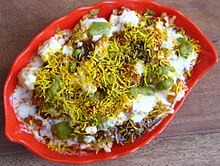

It is the most populous state and is the cultural centre of India. The cuisine of this state is reminiscent of Nawabi and Moghul glory with pleasures. The state is transverse by two famous rivers, the Ganga and the Yamuna which have made the land very fertile and suitable for growing crops. Uttar Pradesh is the largest producer of sugarcane in India. Apart from this the wheat, rice, maize, pulses, milk and milk products are quite in abundance.
The transformation of cooking into fine art was only possible during the Moghul period that introduced dastarkhwan, the ceremonial tradition of laying food on the table. The khansamas from central Asia introduced a variety style like baghare, dhuandhar and dum. There is a lavish use of gram flour, curd and ghee in the vegetarian food of Uttar Pradesh. Ingredients like cream, curd, mawa, cashew nuts, almonds, charoli, poppy seeds and flavouring agents such as cardamom, cinnamon, cloves, bay leaves, star anise, mace and nutmeg are used to prepare the Mughlai foods. Ghee, curd and cream form the essence of gravies with less stress on tomatoes, fried onions are blended to paste and used in gravies like kormas and nehari.
Butter chicken and chicken tikka masala find place in every menu of the world. Kebabs are speciality of Mughlai cuisine and served as snacks as well as mealtime accompaniment. Boti kebabs, tandoori chicken, chicken tikka tingles in every food lover. Rice preparations such as pakki biriyanis and zafrani pulaos are world famous. Different types of bread preparation such as taftan, baquarkhani, kulcha, and naans are prepared in tandoor.
UP is very famous for its sweet dishes. The bazaars of Banaras are full of jalebi. The pethas from Agra are popular all over the country. Some of their popular sweet dishes are kheer, gajjar ka halwa, imrati, rabdi, and burfi and boondi ladoo.
SPECIALITIES: –
JALJEERA: – a drink used as a refresher or starter, made by flavouring water with jeera and mint. It gets sourness from tamarind and other ingredients. It serves with boondi and a mint spring as garnish.
KAKORI KEBAB: – this seekh has long been considered a piece of resistance in the Awadhi dastarkhwan. This kebab was introduced in Lucknow by the Moghuls and was originally prepared from beef mince or skewers and cooked on charcoal fire.
SHAMMI KEBAB: – considered the ‘national kebab of Awadh’. The kebabs are round patties filled with spicy surprises and the tangy ‘kairi’ or raw mango. This is made from minced meat. The texture of kebab is extremely soft and simply melts in the mouth.
NARGISI KOFTA: – the chef of Awadh designed the nargisi kofta. This is essentially a hardboiled egg, wrapped in minced meat and deep fried. When halved lengthwise, it resembles the eye, which is dipped in rich Awadhi gravy.
MURGH WAJID ALI: – a tribute to Awadhi’s best known gourmet, Nawabi wajid Ali shah. This delicacy is of saffron-flavoured chicken breasts which are beaten and rolled onto Khoya masala and done in rich almond based gravy.
SHEERMAL: – a rich bread, its quality is judged by the amount of ghee incorporated in the dough. This bread is authentically made in iron tandoor and milk and saffron water in sprinkled on it while cooking.
ROOMALI ROTI: – also known as handkerchief bread. It is a flat whole-wheat read that is fine, soft and large. Cooked on a convex iron griddle, the fine texture of the bread makes it and excellent accompaniment for delicate kebabs and kormas.
